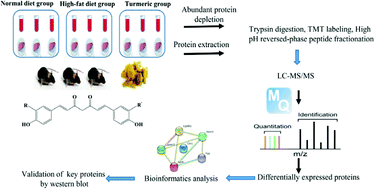Quantitative proteomics of plasma and liver reveals the mechanism of turmeric in preventing hyperlipidemia in mice†
Abstract
Hyperlipidemia is manifested by abnormal levels of circulating lipids and may lead to various cardiovascular diseases. Studies have demonstrated that turmeric supplemented in food can effectively prevent hyperlipidemia. The aim of this study is to elucidate the underlying mechanism. 27 male C57BL/6J mice were randomly divided into three groups, which were fed with a standard diet, a high-fat diet and a high-fat diet supplemented with turmeric powder (2.0% w/w), respectively. After eight weeks of feeding, turmeric intervention significantly reduced the plasma TC, TG, and LDL-C levels and the LDL-C/HDL-C ratio of mice compared with high-fat diet fed mice. TMT-based proteomic analysis showed that the expression of 24 proteins in mouse plasma and 76 proteins in mouse liver was significantly altered by turmeric, respectively. Bioinformatics analysis showed that differential proteins in the plasma were mainly involved in complement and coagulation cascades and the cholesterol metabolism pathway. The differential proteins in the liver were mainly involved in arachidonic acid metabolism, steroid hormone biosynthesis and the PPAR signaling pathway. Key differential proteins were successfully validated by western blot analysis. This study is the first to reveal the preventive mechanism of turmeric on hyperlipidemia from proteomics. The results showed that dietary turmeric could prevent hyperlipidemia through regulating the expression of proteins in metabolism pathways.



 Please wait while we load your content...
Please wait while we load your content...